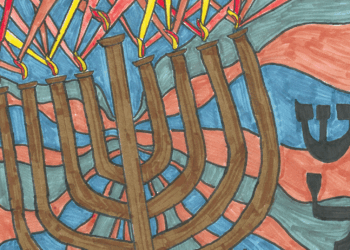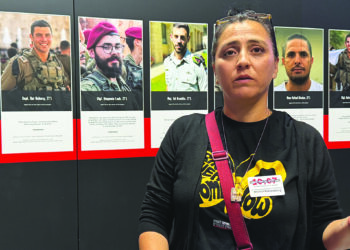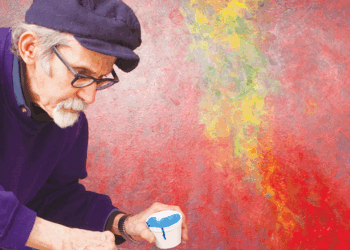Museum in Perham, Minn., hosts exhibit of New York doctor’s woodcarvings that depict Holocaust victims — men, women and children
By MARSHALL HOFFMAN / Special to the AJW
What images do you have of the Holocaust? Whether you’ve studied old newsreels, viewed old photographs or have seen the striped concentration camp uniforms at a Holocaust museum, chances are your images of the victims of this tragic event are in black and white.
But woodcarver Herbert Savel is “trying to put a human face back on these people.” He told the AJW by phone from his Elizabethtown, N.Y., home that “these people were three dimensional people and they had colored clothes.” So he carves images of these victims to make them pop out of the wood, and paints them with bright colors.
The doctor of internal medicine started his carvings in 2002, and has completed more than 1,200 woodcarvings. Each one takes him between 10 and 12 hours to complete. Besides the meticulous carving, Savel also does all the oil painting on the carvings.
“I like helping people,” said the doctor. “Sometimes they’re live people… and sometimes they’re dead children.”
His exhibit of extraordinary woodcarvings, which he calls Kaddish in Wood, is on display through the end of June at the ITOW (In Their Own Words) Veterans Museum in Perham, Minn., about a three-hour drive north of the Twin Cities. It is part of a touring exhibition from the Florida Holocaust Museum.
“The Kaddish is the Jewish prayer for the dead,” Savel explained. “Instead of praying for these children, I’m making three-dimensional memorials to them.”
 Herbert Savel, standing in front of a selection from his 1,200 artworks, holds a carving depicting Eliezer Zilber, a Jewish partisan fighter from Lithuania. (Photos: Courtesy of Dr. Herbert Savel)
Herbert Savel, standing in front of a selection from his 1,200 artworks, holds a carving depicting Eliezer Zilber, a Jewish partisan fighter from Lithuania. (Photos: Courtesy of Dr. Herbert Savel)
The carvings on display in Kaddish in Wood, which are done on basswood from northern Minnesota, are all of French children who were deported to Auschwitz. They are taken from the book French Children of the Holocaust, by Serge Klarsfeld, who spent 20 years gathering some 2,500 photographs of these children. Savel places the actual photograph next to his carvings in the exhibit to show that these are real people.
“Their lives were beautiful,” said Savel. “Their deaths were ugly. I don’t think Holocaust art has to be ugly just because their deaths were ugly.”
Savel works on his carvings in his home studio from 6:30 to 11 p.m. every night, and “from morning ’til night” on weekends. While clay can be a “forgiving” substance for an artist, with wood, Savel insisted, there are no second chances. It’s an unpredictable and rough surface, unlike a painter’s canvas.
 A carving depicts Alain Goltschmitt, one of the one and a half million children murdered by the Nazis.
A carving depicts Alain Goltschmitt, one of the one and a half million children murdered by the Nazis.
He has little time for traveling, although he met with Klarsfeld when the latter came to America. All of his work is done by hand, using an extensive array of chisels in the Alpine carving tradition, a traditional German woodcarving technique dating back to the Middle Ages. In fact, the German school where Savel’s woodcarving teacher was trained now uses machinery to do much of the work. Savel figures he may be one of the last woodcarvers working by hand in this tradition.
“It’s ironic that the last ‘German’ woodcarver carving in the tradition of traditional German woodcarving is a Jewish woodcarver carving pictures of the Holocaust,” he noted.
For Savel, the subject of his art can be quite personal. His mother’s family in Poland was wiped out during the Holocaust, as was his father’s family in Russia during those years. “Every Jew alive today is a Holocaust survivor,” Savel stated; because if Hitler had been successful and not been defeated, all Jews would have been destroyed.
“It would be a different world if some of these kids survived,” he said.
All his carvings use a halo around the subjects which, while often associated with early Christian art, has been used to portray Buddha and for Jewish imagery. There’s a line in the Torah, Savel noted, that when Moses came down from Mount Sinai he had a “radiance about his head so that the people couldn’t look at him.” He also mentioned the Kabbalistic notion that every individual has a divine spark within.
“American Indians believe in an aura. I believe in a divine spark,” he said. “The only way I can portray a divine spark is to use the same yellow halo around the head.”
 One of Savel’s woodcarvings memorializes Tauba amd Eliane Schwirtz, a mother and child who were deported from France to Auschwitz, in 1942, and murdered.
One of Savel’s woodcarvings memorializes Tauba amd Eliane Schwirtz, a mother and child who were deported from France to Auschwitz, in 1942, and murdered.
After working so many hours on each carving, Savel feels he gets to know the subjects, their personalities, whether they were rich or poor, shy or haughty, strong or sickly. That’s why he describes the carvings as “too personal” and “not for sale.” Many hang in his doctor’s office. “When I carve, I’m creating these people.”
“I can’t sell these carvings,” said Savel. “I give them away when appropriate” to certain individuals, colleges or museums.
But with 1,218 carvings behind him, Savel is not slowing down.
“Of course, I’ve got a lot more to do. My goal is to continue carving as a memorial until I can’t do it anymore.”
Savel explained the artistic feeling he gets when it’s time to do the next carving. Referring to the children depicted in Klarsfeld’s book, Savel said, “I hear their voices asking me, ‘What about me?’”
***
Kaddish in Wood runs through June 30. The ITOW Museum is located at 805 W. Main St. in Perham, Minn. Hours of operation are Monday through Saturday, 10 a.m. to 5 p.m., and Sunday 1 to 4 p.m.
Marshall Hoffman is the former managing editor of the American Jewish World.
(American Jewish World, 6.10.11)


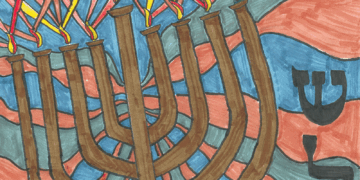
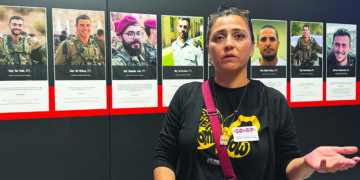





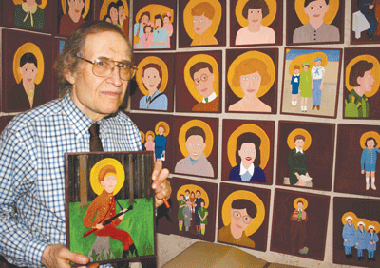 Herbert Savel, standing in front of a selection from his 1,200 artworks, holds a carving depicting Eliezer Zilber, a Jewish partisan fighter from Lithuania. (Photos: Courtesy of Dr. Herbert Savel)
Herbert Savel, standing in front of a selection from his 1,200 artworks, holds a carving depicting Eliezer Zilber, a Jewish partisan fighter from Lithuania. (Photos: Courtesy of Dr. Herbert Savel)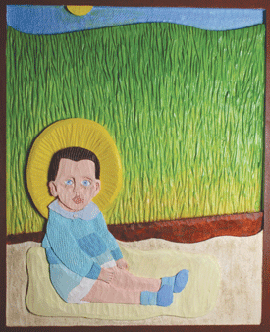 A carving depicts Alain Goltschmitt, one of the one and a half million children murdered by the Nazis.
A carving depicts Alain Goltschmitt, one of the one and a half million children murdered by the Nazis.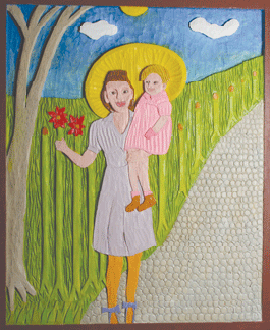 One of Savel’s woodcarvings memorializes Tauba amd Eliane Schwirtz, a mother and child who were deported from France to Auschwitz, in 1942, and murdered.
One of Savel’s woodcarvings memorializes Tauba amd Eliane Schwirtz, a mother and child who were deported from France to Auschwitz, in 1942, and murdered.
